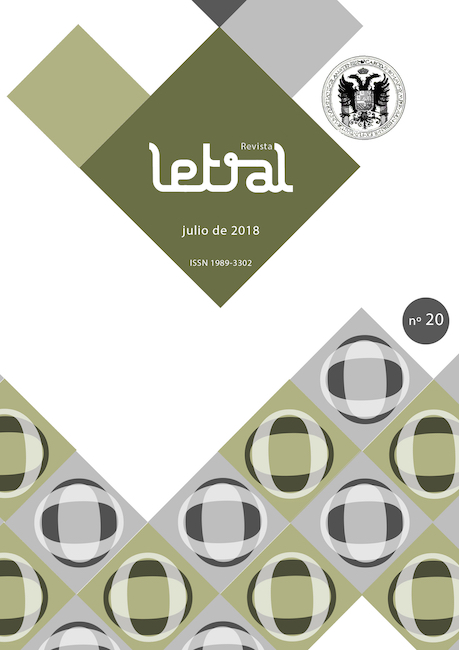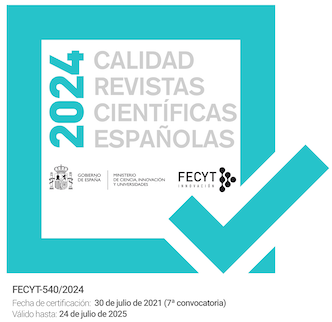Blogs in the Spanish-language writings: retrospective of the literary hoax at the beginning of the 21st century
DOI:
https://doi.org/10.30827/rl.v0i20.8410Keywords:
blogfiction, avatar, hoax, blog, masks, egonarrativeAbstract
The creation of fictional characters in online social media has led to a systematic exploitation of resources that enable these characters to occupy spheres and spaces of presence. Authors hand these digital resources over to their avatar personae, so that the masks used in the virtual scene remove them from the spotlight and hide them –as writers– away from the digital identity they have created. In blogfiction developed within social networks or blogs, thistransfer to the blog-characters is fused with the total impersonation of the author, in a process that is essentially a hoax, and that leads to the creation of long stories or purely atomistic roles. In these, the creation and embodiment of the characters is the ultimate goal, even above narratorial developments. Thus emerge blogfictions that channel the acting drive of the authors to create characters that border on the implausible and that force the covenants of fiction established with the recipients of their work. In this article, we analyse the online antecedents of this phenomenon of bloggers’ impersonations by means of their avatars and how they become a narrative device in those digital literary spaces linked to the blog. This article also discusses the intermedia path that this phenomenon has followed and the evolution of its format, a process parallel to the Social Network, with a particular focus on writings in Spanish.Downloads
References
ABC. “La inquietante historia de Manuel Bartual, tuit a tuit”. ABC,28 agosto 2017, www.abc.es/recreo/abci-manuel-bartual-inquietante-historia-manuel-bartual-tuit-tuit-201708260005_noticia.html.
Aguirre, Carolina. Ciega a citas. Wordpress.com, 2007-208, Ciega a citas ciegaacitas.wordpress.com.
Baudrillard, Jean. Cultura y simulacro. Barcelona, Kairós, 2007.
Bourriaud, Nicolas. Postproduction. Culture as screenplay: How art reprograms the world. Nueva York, Lukas & Sterling, 2002.
Broncano, Fernando. La melancolía del ciborg. Barcelona, Herder,2009.
Carroll, Jon. “The sad yet untrue story of Kaycee”. SF Gate, 5 junio 2001, www.sfgate.com/entertainment/article/The-sad-yet-untruestory-of-Kaycee-3314994.php.
Casciari, Hernán. El diario de Letizia Ortiz. Blogspot.com, 2005,http://letizia-ortiz.blogspot.com.
Casciari, Hernán. “La ficción on line. Un espectáculo en directo”.La blogosfera hispana: pioneros de la comunicación digital, J. M.
Cerezo (dir.), Madrid: Omán Impresores/France Telecom, 2006, pp.171-179.
Casciari, Hernán. Más respeto, que soy tu madre. Bitacoras.com,2003-2004, mujergorda.bitacoras.com.
Casciari, Hernán. Yo y mi garrote. Blog de Xavi L. ElPais.com, 2007,blogs.elpais.com/xavi.
Castronova, Edward. Synthetic Worlds. The Business and Culture of Online Games. Chicago, The University of Chicago Press, 2005. DOI: https://doi.org/10.7208/chicago/9780226096315.001.0001
Crónica Global. “Un tuitero conmociona con el relato de un falso asesinato para ganar un concurso”. Crónica Global, 3 junio 2018,cronicaglobal.elespanol.com/vida/tuitero-relato-falso-asesinatoconcurso_146042_102.html.
Davidson, Paul. The Lost Blogs. From Jesus to Jim Morrison. Nueva York, Warner Books, 2006.
Echeverría, Javier. “Cuerpo electrónico e identidad”. Arte, cuerpo,tecnología, D. Hernández Sánchez (ed.), Salamanca, Ediciones Universidad de Salamanca, 2003, pp. 13-29.
Escandell Montiel, Daniel. “Ciega a citas más allá de las páginas del blog: de la televisión al regreso a Internet en las adaptaciones de la obra de Carolina Aguirre”. Manifestaciones intermediales de la literatura hispánica en el siglo XXI, G. Cordone y V. Béguelin-Argimón (eds.), Madrid, Visor, 2016, pp. 295-309.
Escandell Montiel, Daniel. Escrituras para el siglo XXI. Literatura y blogosfera. Madrid-Fráncfort del Meno, Iberoamericana-Vervuert, 2014. DOI: https://doi.org/10.31819/9783954872350
Escandell Montiel, Daniel. “The Writer Seeking Vengeance: Blognovelism and Its Relationship with Literary Critics”. Best Served Cold.Studies on Revenge, Sheila C. Bibb y Daniel Escandell (eds.), Oxford, ID-Press, 2010, pp. 127-136. DOI: https://doi.org/10.1163/9781848880436_015
Escandell Montiel, Daniel. “Tuiteratura: la frontera de la microliteratura en el espacio digital”. Iberic@l. Revue d’études ibériques et ibéro-américaines, 5, 2014, pp. 37-48.
Foucault, Michel. ¿Qué es un autor? Buenos Aires, Ediciones literales, 1969.
Gache, Belén. El diario del niño burbuja. Findelmundo.com.ar,2004, bubbleboy.findelmundo.com.ar.
Guerrieri, Marcelo. Detective bonaerense. Blogger, 2006, detectivebonaerense.blogspot.com.
Gualda, Diego. Hablalo con mi abogado. Blogspot.com, 2008, hablaloconmiabogado.blogspot.com.
Hafner, Katie. “A Beautiful Life, an Early Death, a Fraud Exposed”.New York Times, 31 mayo 2001, www.nytimes.com/2001/05/31/technology/a-beautiful-life-an-early-death-a-fraud-exposed.html.
Joost, Henry & Schulman, Ariel, directores. Catfish. Universal Pictures, 2010.
Kottke, Jason. “Seems that Plain Layne *is* a hoax”. Kottke.org, 25 junio 2004, kottke.org/04/06/plain-layne-update.
Laddaga, Reinaldo. Espectáculos de realidad. Ensayo sobre la narrativa latinoamericana de las últimas dos décadas. Rosario, Beatriz Viterbo Editora, 2007.
McLuhan, Marshall y Barrington Nevitt. Take Today. The executive as dropout. San Diego, Harcourt Brace Jovanovich 1972.
Mora, Vicente Luis. Alba Cromm. Barcelona, Seix Barral, 2010.
Mora, Vicente Luis. Alba Cromm. Bitacoras.com, 2005, albacromm.bitacoras.com.
Mora, Vicente Luis. Pangea. Sevilla, Fundación José Manuel Lara, 2006. PlayGround. “Dear David: la historia del niño fantasma asesino que está aterrorizando a Twitter”. PlayGroundMag, 30 agosto 2017, www.playgroundmag.net/virales/nino_22801371.html.
Saum-Pascual, Alex. #Postweb! Crear con la máquina y en la red.Madrid-Fráncfort del Meno, Iberoamericana-Vervuert, 2018. DOI: https://doi.org/10.31819/9783954877065
Sibilia, Paula. La intimidad como espectáculo. El Salvador, Fondo de Cultura Económica, 2008.
Silva, Lorenzo. El blog del inquisidor. Barcelona, Destino, 2008.
Soli, Odin. Plain Layne. Dreamhost, 2001-2003, plainlayne.dreamhost.com.
Stephenson, Neal: Snow Crash. Nueva York, Bantam Spectra, 2003.
Tisseron, Serge. L’intimité superexposée. París, Ramsay, 2001.
Toffler, Alvin. The Third Wave. Nueva York, Bantam Books, 1980.
Tomas, Maximiliano. “Que nadie se atreva a tocar a mi Borges: María Kodama y la industria del juicio”. La Nación, 16 abril 2012, www.lanacion.com.ar/1465418-que-nadie-se-atreva-a-tocar-a-mi-borges-maria-kodama-y-la-industria-del-juicio.
Vallejo, Arturo. Diario de una miss intelijente. Crónica de un año de reinado. Ya.com, 2005-2006, blogs.ya.com/soyunamiss.
Vallejo, Arturo. Diario de una miss intelijente pero el segundo año.Blogspot.com, 2006, soyunamiss.blogspot.com.
Downloads
Published
How to Cite
Issue
Section
License
Revista Letral is an open access journal under a Creative Commons Atribución-NoComercial 4.0 license.
The works published in this journal may be reused, distributed and publicly presented for non-commercial purposes, provided that: cite the authorship and the original source of the publication (journal, publisher and URL of the work).
We strongly recommended you to share our published articles in social and scientific networks, institutional and public repositories, personal or institutional websites, blogs, Google Scholar, ORCID, ResearchID, ScopusID, etc.
The journal allow the author(s) to hold the copyright and to retain publishing rights without restrictions.
We are completely free, both for readers and authors.














